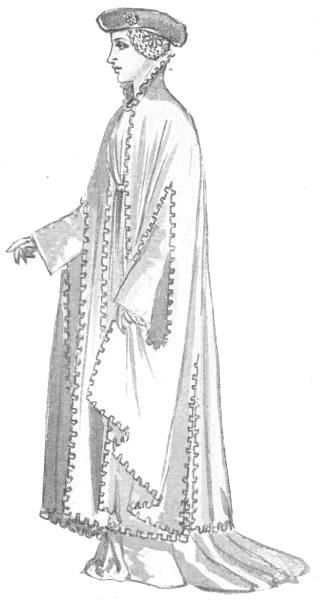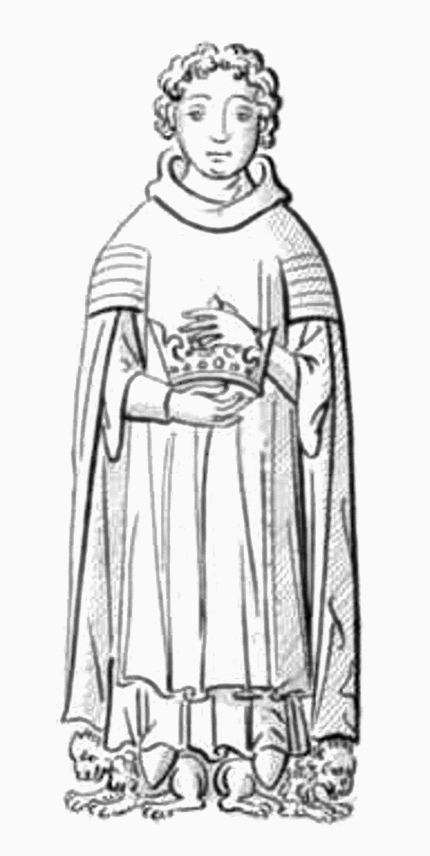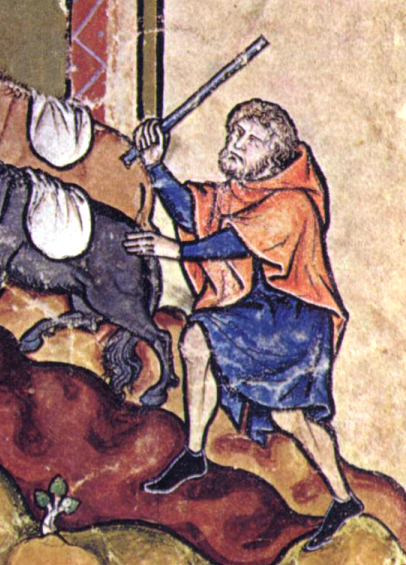|
Houppelande
A houppelande or houpelande is an outer garment, with a long, full body and flaring sleeves, that was worn by both men and women in Europe in the late Middle Ages. Sometimes the houppelande was lined with fur. The garment was later worn by professional classes, and has remained in Western civilization as the familiar academic and legal robes of today. The houppelande appeared around 1360 and was to remain fashionable well into the next century. It had its origins in the herigaut, a similar 13th-century garment with hanging sleeves. The edges of the houppelande were often ''dagged'', or cut into decorative patterns such as scallops, "embattled" tabs or even leaf shapes.Ribiero, Aileen, ''Dress and Morality'', Batsford, 1986, reprinted Berg, 2003, History The term ''houppelande'' is of French origin; in England it was called a ''goun'', a term of mockery, and in Italy, a ''pellanda''. It is first mentioned in French royal inventories in 1359 and is thought to have originated as a m ... [...More Info...] [...Related Items...] OR: [Wikipedia] [Google] [Baidu] |
1400–1500 In European Fashion
Fashion in 15th-century Europe was characterized by a series of extremes and extravagances, from the voluminous robes called houppelandes with their sweeping floor-length sleeves to the revealing doublets and hose of Renaissance Italy. Hats, hoods, and other headdresses assumed increasing importance, and were draped, jewelled, and feathered. As Europe continued to grow more prosperous, the urban middle classes, skilled workers, began to wear more complex clothes that followed, at a distance, the fashions set by the elites. It is in this time period that we begin to see fashion take on a temporal aspect. People could now be dated by their clothes, and being in "out of date" clothing became a new social concern. National variations in clothing seem on the whole to have increased over the 15th century.Boucher, François: ''20,000 Years of Fashion'', Harry Abrams, 1966. General trends New trends emerge among the Danes The Lübeckian chronicler Arnold mocked changes in Danish atti ... [...More Info...] [...Related Items...] OR: [Wikipedia] [Google] [Baidu] |
1300–1400 In European Fashion
Fashion in fourteenth-century Europe was marked by the beginning of a period of experimentation with different forms of clothing. Costume historian James Laver suggests that the mid-14th century marks the emergence of recognizable "fashion" in clothing, in which Fernand Braudel concurs. The draped garments and straight seams of previous centuries were replaced by curved seams and the beginnings of tailoring, which allowed clothing to more closely fit the human form. Also, the use of lacing and buttons allowed a more snug fit to clothing. In the course of the century the length of male hem-lines progressively reduced, and by the end of the century it was fashionable for men to omit the long loose over-garment of previous centuries (whether called tunic, kirtle, or other names) altogether, putting the emphasis on a tailored top that fell a little below the waist—a silhouette that is still reflected in men's costume today. Fabrics and furs Wool was the most important material f ... [...More Info...] [...Related Items...] OR: [Wikipedia] [Google] [Baidu] |
Herigaut
A herigaut is a gown-like garment worn in the thirteenth and early fourteenth centuries. Alternative spellings include herigald, heregaud, gerygoud and herigans. It was three-quarters to full length with hanging sleeves. Sometimes the sleeves were tucked at the top to increase fullness below. Although it was primarily a men's garment, women occasionally wore it as well. Along with the garnache, it is a variant of the garde-corps, and it is also related to the houppelande. References 13th-century fashion 14th-century fashion Medieval European costume Robes and cloaks Gowns {{clothing-stub ... [...More Info...] [...Related Items...] OR: [Wikipedia] [Google] [Baidu] |
15th Century Costume - The Houppelande
15 (fifteen) is the natural number following 14 and preceding 16. Mathematics 15 is: * A composite number, and the sixth semiprime; its proper divisors being , and . * A deficient number, a smooth number, a lucky number, a pernicious number, a bell number (i.e., the number of partitions for a set of size 4), a pentatope number, and a repdigit in binary (1111) and quaternary (33). In hexadecimal, and higher bases, it is represented as F. * A triangular number, a hexagonal number, and a centered tetrahedral number. * The number of partitions of 7. * The smallest number that can be factorized using Shor's quantum algorithm. * The magic constant of the unique order-3 normal magic square. * The number of supersingular primes. Furthermore, * 15 is one of two numbers within the ''teen'' numerical range (13-19) not to use a single-digit number in the prefix of its name (the first syllable preceding the ''teen'' suffix); instead, it uses the adjective form of five (''fif ... [...More Info...] [...Related Items...] OR: [Wikipedia] [Google] [Baidu] |
Clothing
Clothing (also known as clothes, apparel, and attire) are items worn on the body. Typically, clothing is made of fabrics or textiles, but over time it has included garments made from animal skin and other thin sheets of materials and natural products found in the environment, put together. The wearing of clothing is mostly restricted to human beings and is a feature of all human societies. The amount and type of clothing worn depends on gender, body type, social factors, and geographic considerations. Garments cover the body, footwear covers the feet, gloves cover the hands, while hats and headgear cover the head. Eyewear and jewelry are not generally considered items of clothing, but play an important role in fashion and clothing as costume. Clothing serves many purposes: it can serve as protection from the elements, rough surfaces, sharp stones, rash-causing plants, insect bites, by providing a barrier between the skin and the environment. Clothing can insulate against ... [...More Info...] [...Related Items...] OR: [Wikipedia] [Google] [Baidu] |
Europe
Europe is a large peninsula conventionally considered a continent in its own right because of its great physical size and the weight of its history and traditions. Europe is also considered a Continent#Subcontinents, subcontinent of Eurasia and it is located entirely in the Northern Hemisphere and mostly in the Eastern Hemisphere. Comprising the westernmost peninsulas of Eurasia, it shares the continental landmass of Afro-Eurasia with both Africa and Asia. It is bordered by the Arctic Ocean to the north, the Atlantic Ocean to the west, the Mediterranean Sea to the south and Asia to the east. Europe is commonly considered to be Boundaries between the continents of Earth#Asia and Europe, separated from Asia by the drainage divide, watershed of the Ural Mountains, the Ural (river), Ural River, the Caspian Sea, the Greater Caucasus, the Black Sea and the waterways of the Turkish Straits. "Europe" (pp. 68–69); "Asia" (pp. 90–91): "A commonly accepted division between Asia and E ... [...More Info...] [...Related Items...] OR: [Wikipedia] [Google] [Baidu] |
Middle Ages
In the history of Europe, the Middle Ages or medieval period lasted approximately from the late 5th to the late 15th centuries, similar to the post-classical period of global history. It began with the fall of the Western Roman Empire and transitioned into the Renaissance and the Age of Discovery. The Middle Ages is the middle period of the three traditional divisions of Western history: classical antiquity, the medieval period, and the modern period. The medieval period is itself subdivided into the Early, High, and Late Middle Ages. Population decline, counterurbanisation, the collapse of centralized authority, invasions, and mass migrations of tribes, which had begun in late antiquity, continued into the Early Middle Ages. The large-scale movements of the Migration Period, including various Germanic peoples, formed new kingdoms in what remained of the Western Roman Empire. In the 7th century, North Africa and the Middle East—most recently part of the Eastern Ro ... [...More Info...] [...Related Items...] OR: [Wikipedia] [Google] [Baidu] |
Western Culture
Leonardo da Vinci's ''Vitruvian Man''. Based on the correlations of ideal Body proportions">human proportions with geometry described by the ancient Roman architect Vitruvius in Book III of his treatise ''De architectura''. image:Plato Pio-Clemetino Inv305.jpg, upPlato, arguably the most influential figure in all of Western philosophy and has influenced virtually all of subsequent Western and Middle Eastern philosophy and theology. Western culture, also known as Western civilization, Occidental culture, or Western society, is the Cultural heritage, heritage of social norms, ethical values, traditional customs, belief systems, political systems, artifacts and technologies of the Western world. The term applies beyond Europe to countries and cultures whose histories are strongly connected to Europe by immigration, colonization or influence. Western culture is most strongly influenced by Greco-Roman culture, Germanic culture, and Christian culture. The expansion of Greek cul ... [...More Info...] [...Related Items...] OR: [Wikipedia] [Google] [Baidu] |
Academic Dress
Academic dress is a traditional form of clothing for academic settings, mainly tertiary (and sometimes secondary) education, worn mainly by those who have obtained a university degree (or similar), or hold a status that entitles them to assume them (e.g., undergraduate students at certain old universities). It is also known as academical dress, academicals, and, in the United States, as academic regalia. Contemporarily, it is commonly seen only at graduation ceremonies, but formerly academic dress was, and to a lesser degree in many ancient universities still is, worn daily. Today, the ensembles are distinctive in some way to each institution, and generally consist of a gown (also known as a robe) with a separate hood, and usually a cap (generally either a square academic cap, a tam, or a bonnet). Academic dress is also worn by members of certain learned societies and institutions as official dress. Overview and history The academic dress found in most universities in the C ... [...More Info...] [...Related Items...] OR: [Wikipedia] [Google] [Baidu] |
Chaperon (headgear)
A chaperon ( or ; Middle French: ''chaperon'') was a form of hood or, later, highly versatile hat worn in all parts of Western Europe in the Middle Ages. Initially a utilitarian garment, it first grew a long partly decorative tail behind called a liripipe, and then developed into a complex, versatile and expensive headgear after what was originally the vertical opening for the face began to be used as a horizontal opening for the head. It was especially fashionable in mid-15th century Burgundy, before gradually falling out of fashion in the late 15th century and returning to its utilitarian status. It is the most commonly worn male headgear in Early Netherlandish painting, but its complicated construction is often misunderstood. Humble origins The chaperon began before 1200 as a hood with a short cape, put on by pulling over the head, or fastening at the front. The hood could be pulled off the head to hang behind, leaving the short cape round the neck and shoulders. The edge ... [...More Info...] [...Related Items...] OR: [Wikipedia] [Google] [Baidu] |
Très Riches Heures Du Duc De Berry
The Très Riches Heures du Duc de Berry (; en, The Very Rich Hours of the Duke of Berry) or Très Riches Heures, is the most famous and possibly the best surviving example of manuscript illumination in the late phase of the International Gothic style. It is a book of hours: a collection of prayers to be said at the canonical hours. It was created between and 1416 for the extravagant royal bibliophile and patron John, Duke of Berry, by the Limbourg brothers.Manion 1996, p. 308. When the three painters and their sponsor died in 1416, possibly victims of plague, the manuscript was left unfinished. It was further embellished in the 1440s by an anonymous painter, who many art historians believe was Barthélemy d'Eyck. In 1485–1489, it was brought to its present state by the painter Jean Colombe on behalf of the Duke of Savoy. Acquired by the Duc d'Aumale in 1856, the book is now MS 65 in the Musée Condé, Chantilly, France. Consisting of a total of 206 leaves of very fine ... [...More Info...] [...Related Items...] OR: [Wikipedia] [Google] [Baidu] |
14th-century Fashion
As a means of recording the passage of time, the 14th century was a century lasting from 1 January 1301 ( MCCCI), to 31 December 1400 ( MCD). It is estimated that the century witnessed the death of more than 45 million lives from political and natural disasters in both Europe and the Mongol Empire. West Africa experienced economic growth and prosperity. In Europe, the Black Death claimed 25 million lives wiping out one third of the European population while the Kingdom of England and the Kingdom of France fought in the protracted Hundred Years' War after the death of Charles IV, King of France led to a claim to the French throne by Edward III, King of England. This period is considered the height of chivalry and marks the beginning of strong separate identities for both England and France as well as the foundation of the Italian Renaissance and Ottoman Empire. In Asia, Tamerlane (Timur), established the Timurid Empire, history's third largest empire to have been ever establ ... [...More Info...] [...Related Items...] OR: [Wikipedia] [Google] [Baidu] |

.jpg)








